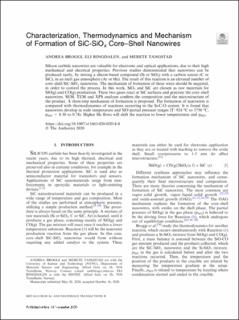| dc.contributor.author | Broggi, Andrea | |
| dc.contributor.author | Ringdalen, Eli | |
| dc.contributor.author | Tangstad, Merete | |
| dc.date.accessioned | 2021-02-26T07:21:30Z | |
| dc.date.available | 2021-02-26T07:21:30Z | |
| dc.date.created | 2019-11-25T08:48:03Z | |
| dc.date.issued | 2020 | |
| dc.identifier.citation | Metallurgical and Materials Transactions B. 2020, 1-12. | en_US |
| dc.identifier.issn | 1073-5615 | |
| dc.identifier.uri | https://hdl.handle.net/11250/2730530 | |
| dc.description.abstract | Silicon carbide nanowires are valuable for electronic and optical applications, due to their high mechanical and electrical properties. Previous studies demonstrated that nanowires can be produced easily, by mixing a silicon-based compound (Si or SiO2) with a carbon source (C or SiC), in an inert gas atmosphere (Ar or He). The result of this reaction is an elevated number of core–shell SiC-SiOx nanowires. The mechanism of formation of these wires should be inquired, in order to control the process. In this work, SiO2 and SiC are chosen as raw materials for SiO(g) and CO(g) production. These two gases react at SiC surfaces and generate the core–shell nanowires. SEM, TEM and XPS analyses confirm the composition and the microstructure of the product. A three-step mechanism of formation is proposed. The formation of nanowires is compared with thermodynamics of reactions occurring in the Si-C-O system. It is found that nanowires develop in wide temperature and SiO partial pressure ranges (T: 924 °C to 1750 °C, pSiO = 0.50 to 0.74). Higher He flows will shift the reaction to lower temperatures and pSiO. | en_US |
| dc.language.iso | eng | en_US |
| dc.publisher | Springer | en_US |
| dc.rights | Navngivelse 4.0 Internasjonal | * |
| dc.rights.uri | http://creativecommons.org/licenses/by/4.0/deed.no | * |
| dc.title | Characterization, thermodynamics and mechanism of formation of SiC-SiOx core–shell nanowires | en_US |
| dc.type | Peer reviewed | en_US |
| dc.type | Journal article | en_US |
| dc.description.version | publishedVersion | en_US |
| dc.source.pagenumber | 1-12 | en_US |
| dc.source.journal | Metallurgical and Materials Transactions B | en_US |
| dc.identifier.doi | 10.1007/s11663-020-02014-4 | |
| dc.identifier.cristin | 1751625 | |
| dc.relation.project | Norges forskningsråd: 269431 | en_US |
| cristin.ispublished | true | |
| cristin.fulltext | postprint | |
| cristin.fulltext | original | |
| cristin.qualitycode | 2 | |

